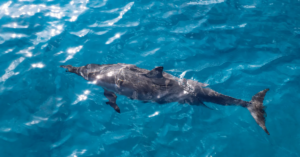Short Answer: Yes.
Underwater noise pollution poses a significant threat to dolphins, disrupting their natural behaviors and communication abilities. Dolphins rely heavily on their sophisticated echolocation system, using sound waves to navigate, locate prey, and communicate with one another. However, human activities, such as shipping, construction, and offshore drilling, introduce an increasing amount of noise into the oceans, which can have detrimental effects on these intelligent marine mammals.
Firstly, the noise from commercial vessels and recreational boats can lead to a phenomenon known as “masking.” This occurs when the ambient noise in the water overwhelms the sounds dolphins emit, making it challenging for them to detect and locate food or communicate effectively. This interference can disrupt their feeding habits, leading to potential malnourishment and a decline in overall health.
Secondly, underwater construction and seismic exploration can produce intense and prolonged noise, causing physical discomfort and stress for dolphins. Sudden loud noises can startle and disorient them, while continued exposure to these disturbances can disrupt their daily routines, breeding patterns, and migration routes.
Thirdly, noise pollution can isolate dolphins socially. Dolphins are highly social animals that rely on complex vocalizations to communicate with their pod members. Excessive noise can hinder their ability to hear and respond to these important calls, leading to fragmentation and disorganization within the groups.
Furthermore, underwater noise pollution can contribute to habitat degradation. Dolphins depend on acoustically rich environments for successful navigation and foraging. Excessive noise can alter their perception of the surrounding habitat, potentially leading them into dangerous areas or away from critical feeding grounds.
In addition to the immediate impacts on individual dolphins, prolonged exposure to underwater noise pollution can have long-term consequences for their populations. It can lead to chronic stress, decreased reproductive success, and even increased vulnerability to predation.
Addressing underwater noise pollution is crucial for the well-being and conservation of dolphins. Implementing measures such as reducing ship speeds, using quieter marine equipment, and establishing marine protected areas can help mitigate the effects of noise pollution on these magnificent creatures, ensuring their continued presence and contribution to the marine ecosystem. By prioritizing their welfare and taking steps to reduce underwater noise, we can protect the future of dolphins and preserve the health of our oceans.

How do dolphins adapt to noise pollution?
These adaptations are essential for their survival and to cope with the challenges posed by human-generated noises in their environment. Some of the ways dolphins adapt to noise pollution include:
- Altered Communication: Dolphins can adjust their vocalizations to overcome the effects of background noise. They may use higher frequencies or change the timing and intensity of their calls to be better heard by other members of their pod.
- Changes in Behavior: In areas with high noise levels, dolphins may alter their behavior to avoid noisy locations or times. For example, they might adjust their feeding, mating, or migration patterns to reduce exposure to loud sounds.
- Increased Vocalization: Dolphins may increase their vocal activity in response to elevated background noise. By producing more calls, they can maintain communication within their pod despite the added acoustic challenges.
- Social Cohesion: In noisy environments, dolphins may display more cohesive group behavior. Staying close together enhances their ability to transmit and receive important communication signals even in the presence of background noise.
- Echolocation Adaptations: Dolphins could adapt their echolocation strategies in response to noise pollution. They may alter the frequency range or intensity of their clicks to minimize interference from anthropogenic sounds and to better detect prey and navigate.
- Habituation: In some cases, dolphins may become habituated to certain levels of noise over time. While chronic exposure to noise pollution is detrimental, habituation may temporarily reduce the immediate stress response.
- Movement to Quieter Areas: Dolphins are known to be highly mobile creatures. When faced with excessive noise in a specific area, they may move to quieter regions where the acoustic environment is less disturbed.
It is essential to recognize that these adaptations may help dolphins to some extent, but they do not eliminate the negative impacts of noise pollution entirely. Prolonged exposure to high levels of underwater noise can still have significant consequences on their health, behavior, and overall well-being. To protect dolphins and other marine life from the harmful effects of noise pollution, it is vital to implement effective conservation measures, including reducing human-generated noise, establishing marine protected areas, and conducting further research to better understand the long-term impacts of noise pollution on these intelligent creatures.











